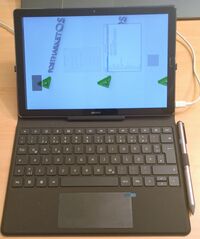Huawei Mediapad M5 pro (huawei-cameron)
Appearance
| This device runs a Downstream kernel. Some UIs will not work, and most features (3D acceleration, audio, etc.) may be broken. |
 Huawei Mediapad M5 pro with accessory keyboard-case and stylus | |
| Manufacturer | Huawei |
|---|---|
| Name | Mediapad M5 pro |
| Codename | huawei-cameron |
| Released | 2018 |
| Type | tablet |
| Hardware | |
| Chipset | HiSilicon Kirin 960 |
| CPU | Cortex-A73/-A53 |
| GPU | ARM Mali-G71 MP8 |
| Display | 10.8 inch 16:10, 2560 x 1600 pixel, native pen support |
| Storage | 64 GB eMMC Flash |
| Memory | 4096 MB |
| Architecture | aarch64 |
| Software | |
Original software The software and version the device was shipped with. |
Android 8 Oreo (EMUI 8.0) |
Extended version The most recent supported version from the manufacturer. |
Android |
| postmarketOS | |
| Category | downstream |
Mainline Instead of a Linux kernel fork, it is possible to run (Close to) Mainline. |
no |
| Device package |
|
| Kernel package |
|
Flashing Whether it is possible to flash the device with pmbootstrap flasher. |
Broken
|
|---|---|
USB Networking After connecting the device with USB to your PC, you can connect to it via telnet (initramfs) or SSH (booted system). |
Works
|
Battery Whether charging and battery level reporting work. |
Untested
|
Screen Whether the display works; ideally with sleep mode and brightness control. |
Works
|
Touchscreen |
Works
|
| Multimedia | |
3D Acceleration |
Untested
|
Audio Audio playback, microphone, headset and buttons. |
Untested
|
Camera |
Untested
|
| Connectivity | |
WiFi |
Broken
|
Bluetooth |
Untested
|
GPS |
Untested
|
| Modem | |
Calls |
Untested
|
SMS |
Untested
|
Mobile data |
Untested
|
| Miscellaneous | |
FDE Full disk encryption and unlocking with unl0kr. |
Untested
|
| Sensors | |
Accelerometer Handles automatic screen rotation in many interfaces. |
Untested
|
Contributors
- JohnBergago
Device owners
How to enter flash mode
With power off, press power und volume-down at the same time, with the usb-cable plugged in.
How to flash
As Huawei changed the partition layout, there is no boot partition anymore. Instead there is a ramdisk and a seperate kernel partition. In order to create the correct images the following steps need to be done:
- Get mkbootimg and unpackbootimg i.e. from here.
- You can extract the kernel-image and ramdisk from the created boot.img with unpackbootimg.
$ # copy created boot image to current directory $ cp ~/.local/var/pmbootstrap/chroot_rootfs_huawei-cameron/boot/boot.img-huawei-cameron . $ # extract the created boot.img $ mkdir pmos-boot-huawei-cameron $ unpackbootimg -i boot.img-huawei-cameron -o pmos-boot-huawei-cameron/ $ # copy created boot image to current directory $ cp ~/.local/var/pmbootstrap/chroot_rootfs_huawei-cameron/boot/boot.img-huawei-cameron . $ # extract the created boot.img $ mkdir pmos-boot-huawei-cameron $ unpackbootimg -i boot.img-huawei-cameron -o pmos-boot-huawei-cameron/
- Use the extracted files in the following steps.
- Create ramdisk image:
$ # create new ramdisk image with empty kernel (empty.file size is 0) $ ./android-unpackbootimg/mkbootimg.py --kernel empty.file --ramdisk pmos-boot-huawei-cameron/boot.img-huawei-cameron-ramdisk.gz --cmdline 'buildvariant=user' --os_version 8.0.0 --os_patch_level 2018-06-05 -o pmos-cameron.ramdisk.img
- Create kernel image:
$ # kernel (with empty.file size is 0): $ mkbootimg.py --kernel pmos-boot-huawei-cameron/boot.img-huawei-cameron-zImage --ramdisk empty.file --cmdline 'loglevel=4 initcall_debug=y page_tracker=on slub_min_objects=16 unmovable_isolate1=2:192M,3:224M,4:256M printktimer=0xfff0a000,0x534,0x538 androidboot.selinux=enforcing buildvariant=user' --base 0x0 --kernel_offset 524288 --ramdisk_offset 130023424 --second_offset 15728640 --tags_offset 0x7a00000 --os_version 8.0.0 --os_patch_level 2018-12 -o pmos-cameron.kernel.img
- Flash ramdisk and kernel with fastboot:
$ fastboot flash kernel pmos-cameron.kernel.img $ fastboot flash ramdisk pmos-cameron.ramdisk.img
Additional Kernel Configuration
OASES
About
OASES stands for Open Adaptive Security Extensions. Its a Tradmark of Baidu and seems to have something todo with adaptive kernel live-patching. For now there were no disadvantages from disabling it.
-> Device Drivers
-> Huawei Platform Drivers
-> Huawei platform drivers support (HUAWEI_PLATFORM [=y])
In Order to compile the kernel OASES had to be disabled.
Additional Info
The display brightness can be set by writing a value between 0 and 9960 to /sys/class/leds/lcd_backlight0/brightness.
$ sudo -i
# echo 1024 > /sys/class/leds/lcd_backlight0/brightness
For now the backlight is completely dark when the system boots.